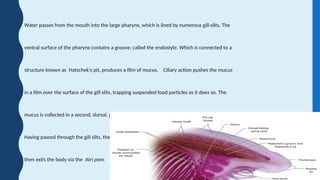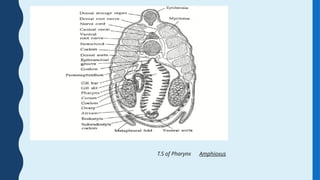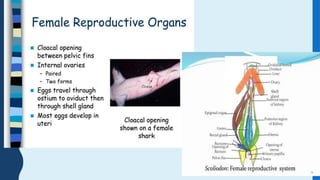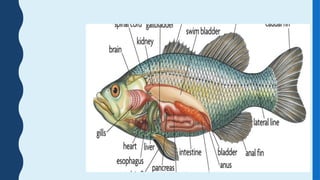chordata. lectures from protochordata until mammles pptx
- 1. Chordata Lectures Prepared by Dr. Mervat El alfy BIOLOGY DEPARTMENT BISHA UNIVERSITY ,KSA (2024-2025)
- 2. L E C T U R E N O . 1
- 3. Animal kingdom is basically divided into two sub kingdoms: (a) Non-chordata- including animals without notochord. (b) Chordata- This comprising animals having notochord . While the Chordata has a notochord at some stage during the life, it is not known to exist in the Non-Chordata. •The Chordata is the animal phylum with which everyone is most intimately familiar, since it includes humans and other vertebrates However, not all chordates are vertebrates. •All chordates have the following features at some stage in their life (in the case of humans and many other vertebrates, these features may only be present in the embryos). •Pharyngeal slits – a series of openings that connect the inside of the throat to the outside of the “neck”. These are often, but not always, used as gills. •Dorsal tubular nerve cord – A bundle of nerve fibers which runs down the “back”. It connects the brain with the lateral muscles and other organs. •Notochord – cartilaginous rod running underneath, and supporting, the nerve cord. •Post-anal tail – an extension of the body post the anal opening.
- 6. PHYLUM: CHORDATA Group ACRANIA (=PROTOCHORDATA) (Primitive chordates without head and vertebral column) Subphylum HEMICHORDATA, Example Balanoglossus
- 7. GENERAL CHARACTERS OF HIMICHORDATA •Bilaterally symmetrical and exclusively marine, worm- like and soft bodied animals. •Body cavity a true coelom (enterocoel). •Body divided into three sections, Proboscis, collar and trunk. Numerous paired gill-slits are present. •Digestive tube complete, straight or U-shaped. •Nervous system normally diffuses, but variable and partially open circulatory system. •Possesses Glomerulus as an excretory organ and reproduction normally sexual, sexes usually •separate but few acorn worms also exhibit asexual reproduction. •Fertilization external in sea water .Development direct or indirect with a free swimming tornaria •larva. Feeds on fine particles in the water.
- 9. L E C T U R E N O . 2
- 11. The urochordates, sometimes known as the tunicates, are commonly known as "sea squirts. The body of an adult tunicate is quite simple, being essentially a sack with two siphons through which water enters and exits. Water is filtered inside the sack-shaped body. Urochordates are small marine animals with larvae that swim freely and adults that attach themselves to the ocean floor.
- 12. 1. Atrial cavity surrounds the pharynx, into this cavity the gill slits, anus and genital ducts will Open. It opens through atrial aperture. 2. Larva has notochord in the tail. It disappears during metamorphosis. 3. Respiratory system contains gills in the pharyngeal wall. 4. Open type of Circulatory system . 5. Nervous system is represented by a single dorsal ganglion in the adult. 6. Excretion is carried on by nephrocytes. 7. Asexual reproduction is by budding, Bisexual animal and Fertilization. is external
- 13. Urochordate’s-resemblance with Chordate. :- Urochordates resemble the chorates owing to the following features- • Presence of dorsal tubular nerve cord. • Presence of notochord. • Well developed pharynx with gill-slits. • Presence of endostyle on the ventral side of the pharynx. • Presence of atrium around the pharynx. • Presence of post - anal tail with tail fin. Because of these chordate features tunicates are included in chordate’s group.
- 16. Cephalochordates : have all the typical chordate features. The dorsal nerve cord is supported by a muscularized rod, or notochord. The pharynx is perforated by over 100 pharyngeal slits or "gill slits", which are used to strain food particles out of the water. The musculature of the body is divided up into V- shaped blocks, or myomeres, and there is a post-anal tail. All of these features are shared with vertebrates. On the other hand, cephalochordates lack features found in most or all true vertebrates: the brain and the sense organs are very small and poorly developed, and there are no true vertebrae.
- 18. Water passes from the mouth into the large pharynx, which is lined by numerous gill-slits. The ventral surface of the pharynx contains a groove; called the endostyle. Which is connected to a structure known as Hatschek's pit, produces a film of mucus. Ciliary action pushes the mucus in a film over the surface of the gill slits, trapping suspended food particles as it does so. The mucus is collected in a second, dorsal, groove, and passed back to the rest of the digestive tract. Having passed through the gill slits, the water enters an atrium surrounding the pharynx, and then exits the body via the Atri pore.
- 21. T.S of Pharynx Amphioxus
- 22. Nervous system Amphioxus possesses a hollow nerve cord running along the anterior- posterior end of the body. Unlike vertebrates, the dorsal nerve cord is not protected by bone but by a simple notochord made of a cylinder of cells, to form a toughened rod. REPRODUCTION IN AMPHIOXUS Amphioxus is a unisexual animal. Amphioxus shows 26 pairs of Gonads. They are present from 25th myotomal segments to 51. Gonads have no ducts.
- 23. L E C T U R E N O . 3
- 27. Cyclostomata is a group of chordates that comprises the living jawless fishes: • the lampreys and hagfishes. • Both groups have round mouths that lack jaws but have retractable horny teeth. • The name Cyclostomata means "round mouths". • Their mouths cannot close due to the lack of a jaw, so they have to constantly cycle water through the mouth. 1. The body is long, eel like. It has a trunk and a compressed tail. 2. Paired fins are absent. Median fin is supported by cartilaginous fin-rays. 3. The skin i.e soft and smooth. It is slimy. It is scale less. 4. Z- shaped myomeres are present in the trunk and tail Protractor and retractors muscles . 5. These vertebrates do not have jaws, hence called Agnetha. 6. The mouth is circular. It works like a sucker and is surrounded by tentacles. 7. Tongue bears teeth. 8. 10. Stomach is absent and esophagus leads into the intestine.
- 28. lampreys can be flesh-feeders or blood-feeders, depending primarily on the structure of their teeth. Feeding behavior is characterized by rhythmic rasping, negative pressure pulses in the sucker, and swallowing of fluid into the gut.
- 29. The Digestive System The digestive system consists of the alimentary canal, which runs from the mouth to the anus. Food enters the food enters the mouth and moves through the pharynx into the esophagus. The adult lamprey is an ectoparasite and its food is in the form of fish blood. A lamprey does not have a stomach. Circulatory System: Blood flows through a series of vessels to supply oxygen and nutrients to the body and to remove carbon dioxide and other wastes.–Arteries and arterioles carry blood away from the heart–Veins and venules carry blood back towards the heart–Capillaries are the smallest vessels where the gases are exchanged with the cells of the body
- 30. Nervous system Lampreys have a primitive nervous system, the brain structure is fairly simple compared to other vertebrate animals. System consists of the brain and a hollow spinal cord–Situated above the alimentary canal.
- 31. Respiratory Systems: A lamprey “breathes” by extracting the oxygen present in the water in which it lives. Within the respiratory tube are seven gill pouches, each containing the finer feather-like gill lamellae.
- 32. LIFE CYCLE OF LAMPERY
- 33. L E C T U R E N O . 4
- 36. A fish is a group of organisms that consist of all gill- bearing aquatic craniate animals that lack limbs with digits. Included in this definition are the living hagfish, lampreys, and cartilaginous and bony fish. Most fish are ectothermic ("cold-blooded"), allowing their body temperature to vary as ambient temperature changes though some of the large active swimmers . Fishes Chondrichthyes:- The members of the Chondrichthyes are cartilaginous fishes possess’ true bone and also posses a skeleton made up of cartilage. Only the teeth of this species and rarely the vertebrae are calcified. Sharks, Skates, and Rays make up the group of Chondrichthyes. Osteichthyes:- About 30000 species of bony fish are found in this class. Skins are protected by protective scales. Some fishes of this category have actual lungs to breathe and also have sharp eyesight.
- 37. Bony fish are again classified into ray finned and lobe finned fish. Ray finned fish have thin, flexible skeleton rays. Lobe finned fish have muscular fins supported by bones. Chondrichthyes:- (dog fish) Scoliodon is widely distributed in India, Pacific West India and eastern coasts of South America and Atlantic Oceans. The common Indian dogfish ,which means “Black Shark
- 38. Placoid scales: Placoid scales are found in the cartilaginous fishes. They are also called dermal denticles. The scales are supported by spines, which feel rough when stroked in a backward direction but, when flattened by the forward movement of water.
- 39. Digestive system: Digestive system consists of alimentary canal and associated glands. Alimentary canal: It is complete and is divided into buccal cavity, pharynx, esophagus, stomach, intestine and rectum.
- 40. Respiratory System: In Scoliodon respiration takes place through 5 pairs of gill slits or gill pouches. They are present in a series on the wall of pharynx on either lateral side .
- 41. Circulatory system : 1- Thin-walled, flat called sinus veno Circulatory system consists of Four chambers. 2- Second chamber called auricles, in which the sinus venosus is open 3- Muscular chamber, thick walled chamber called ventricle 4- conus arteriosus
- 44. L E C T U R E N O . 5
- 45. Osteichthyes ( bony fishes)
- 47. Tilapia Nilotica
- 51. Digestive System: stomach, intestine, pancreas, liver, pyloric caecae • Pyloric caecae - slender tubes that secrete digestive enzymes • Plant eaters = long intestine, Meat eaters = short intestines
- 52. Urinogenital system: Excretory system ❖consists of two elongated kidney, ❖two short mesonephric duct (the two ducts unite after leaving the kidney to form a common mesonephric duct), ❖small urinary bladder and urogenital papilla. *Reproduction system The male reproductive system in bony fish consists of two testes, vas deference and open on urogenital papilla, The female reproductive system consists of two ovaries, oviduct and open on genital papilla.
- 54. Circulatory system Circulatory system consists of three chambers 1- Sinus venosus 2- second chamber called auricles, in which the sinus venosus is open 3- Muscular chamber, thick walled chamber called ventricle Conus Arteriosus is absent in bony fishes
- 55. The nervous system of a fish: is similar to that of other vertebrates. They contain a central nervous system containing a brain and spinal cord and a peripheral nervous system containing the various nerves throughout the body.
- 56. L E C T U R E N O . 6
- 62. Respiratory system: Most amphibians breathe through lungs and their skin. Their skin has to stay wet in order for them to absorb oxygen so they secrete mucous to keep their skin moist (If they get too dry, they cannot breathe and will die).
- 63. The digestive system of amphibians has two major components, a digestive tract, and digestive glands. The digestive tract starts from the mouth and ends as the anus, emptying into the cloaca.
- 66. In amphibians, the urogenital system consists of the testicles attached to fat bodies and accessory ducts . They are located above the testicles and are whitish, yellowish, or orange in color. The testicles are located in the ventral region of the kidney in the abdominal cavity.
- 67. The nervous system is basically the same as in other vertebrates, with a central brain, a spinal cord, and nerves throughout the body
- 68. The front limbs consist of a humerus and a radio-ulna, and the frog's wrist bones, or carpals, articulate with the radio-ulna. The hind limbs, two tarsal bones (tibiale and fibulare) have elongated to form a third leg segment that adds approximately two body-lengths to frogs' maximum jumping distance.
- 69. L E C T U R E N O . 7
- 74. The scales of reptiles prevent them from absorbing oxygen through their skin, as amphibians can. Instead, reptiles breathe air only through their lungs. However, their lungs are more efficient than the lungs of amphibians, with more surface area for gas exchange
- 76. The digestive system of modern reptiles is similar in general plan to that of all higher vertebrates. It includes the mouth and its salivary glands, the esophagus, the stomach, and the intestine and ends in a cloaca.
- 77. Most reptiles reproduce sexually and have internal fertilization. Males have one or two penises that pass sperm from their cloaca to the cloaca of a female. Fertilization occurs within the cloaca, and fertilized eggs leave the female's body through the opening in the cloaca
- 78. L E C T U R E N O . 8
- 81. They are called pneumatic bones and include the skull, humerus, clavicle, keel (sternum), pelvic girdle, and the lumbar and sacral vertebrate. Another important type of bone in the avian skeleton is medullary bones. These include the tibia, femur, pubic bone, ribs, ulna, toes and scapula.
- 82. Like mammals, birds have nares, a larynx, trachea and lungs. In addition, they have nine air sacs and a syrinx (vocal center). Unlike mammals, they have no diaphragm and there is a unidirectional air flow that requires two full inspiratory and expiratory cycles to complete. Birds have air sacs located in front of and behind the lungs, while mammals have air sacs within the lungs. Birds inhale and exhale twice for every respiration, whereas mammals inhale and exhale once per respiration. Mammalian respiratory systems also
- 83. The digestive order is as follows: bill, mouth, tongue, pharynx, esophagus, crop, proventriculus, gizzard, small intestine, caeca, rectum, cloaca.
- 85. The avian nervous system can be divided into the central nervous system which comprises the brain and spinal cord and the peripheral nervous system which includes the cranial and spinal nerves, their ganglia and plexi and the peripheral portions of the autonomic nervous system.
- 86. The avian reproductive system is heterosexual and requires both a male and a female, each to contribute half of the genetic constitution of the offspring. The male contributes his half by way of the sperm produced by the testes and carried in the semen.
- 87. L E C T U R E N O . 9
- 90. There are 46 bones that make up the spinal column alone, 7 cervical (the neck), 12 thoracic (the chest), 7 lumbar (the lower back), 4 sacral (the pelvis) and 16 (the tail). A rabbit's bones have extremely thin cortices and are easily shattered.
- 92. In mammals, air is warmed and humidified in the nasal cavity. Air then travels down the pharynx, through the trachea, and into the lungs. In the lungs, air passes through the branching bronchi, reaching the respiratory bronchioles, which house the first site of gas exchange. Internal respiration: It involves the exchange of gases between tissue fluids and the blood. External respiration: It involves a gas exchange between inhaled air and the pulmonary blood. Cellular respiration: It involves aerobic and anaerobic respiration.
- 94. The heart is divided into four chambers consisting of two atria and two ventricles; the atria receive blood, while the ventricles pump blood. The right atrium receives blood from the superior and inferior vena caves and the coronary sinus; blood then moves to the right ventricle where it is pumped to the lungs
- 95. In mammals, the digestive tract is made up of multiple organs such as the stomach, pancreas, and intestines. These all work together to form the alimentary canal we use to digest food.
- 97. The nervous system of rabbit consists of three divisions: 1. The central nervous system including brain and spinal cord. 2. The peripheral nervous system including nerves coming out from the brain and spinal cord, i.e., cranial nerves and spinal nerves.
- 98. The rabbit's male reproductive system consists of a pair of ovoid-shaped testes. Scrotal sacs in the abdominal cavity contain the testes. Seminiferous tubules are a type of tiny tubule found in each testis. These network of tubules leads to the epididymis, a coiled tubule that leads to the vas deferens, the sperm duct. The female reproductive system in rabbit consists of a pair of ovaries which are small ovoid structures. A pair of oviducts opens into the body cavity by a funnel shaped opening from each side of the ovary. The anterior part of the oviduct is the fallopian tube. It leads into a wider tube called uterus.


































































































